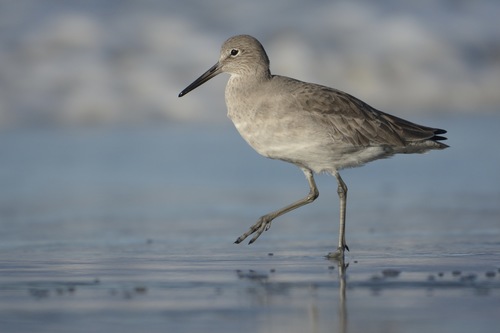
Willet
The Willet (Tringa semipalmata) is a large shorebird in the sandpiper family, notable for its striking black and white wing pattern visible in flight. It plays a crucial role in coastal and wetland ecosystems, primarily as a predator of invertebrates. It is divided into two subspecies with distinct ranges and some differences in size and plumage. The Willet holds no major cultural significance, although its conspicuous presence and distinctive calls make it a familiar sight and sound for those who frequent its habitats.
33-41 cm
Length
65-80 cm
Wingspan
Least Concern
Conservation Status
Distribution
The Willet has two distinct populations. The Eastern Willet breeds along the Atlantic coast of North America, from Nova Scotia to Mexico and the Caribbean. The Western Willet breeds in inland North America, from southern Canada to northern California and Nevada. Both populations are migratory, wintering along the coasts of North, Central, and South America, with some reaching as far south as Chile and Argentina. The Eastern Willets migrate along the Atlantic Flyway, while Western Willets utilize various routes, including the Pacific and Central Flyways.
Lifespan
The oldest recorded Willet was over 10 years old, based on banding records. Average lifespan is likely shorter.
Willet's Habitat
Habitat Types
Coastal salt marshes, Mudflats, Mangrove swamps, Sandy beaches, Prairie potholes (Western Willet), Inland wetlands (Western Willet)
Climate Zones
Temperate, Subtropical, Tropical
Adaptations
Willets have long legs and bills adapted for probing in mud and sand for prey. Their slightly webbed feet aid in walking on soft substrates. They are tolerant of a range of salinities, allowing them to utilize various coastal and inland wetland habitats.
Variations
There are two recognized subspecies: *T. s. semipalmata* (Eastern Willet) and *T. s. inornata* (Western Willet). The Western Willet is generally larger and paler, with less distinct barring on its underparts in breeding plumage.
Appearance
Breeding Plumage
Breeding plumage is mottled grayish-brown above and whitish below with barring on the breast and flanks. Non-breeding plumage is plainer gray above and white below. The most distinctive feature is the bold black and white wing pattern, visible in flight in all plumages.
Seasonal Feather Changes
The transition between breeding and non-breeding plumage occurs through molting, typically starting in late summer after breeding and completing by early spring.
Sex Based Plumage Differences
There is slight sexual dimorphism, with females tending to be slightly larger and sometimes having slightly less distinct markings.
Notable Features
Bold black and white wing pattern, Long, straight, dark bill, Long, grayish legs
Diet and Feeding
Primary Foods
Crabs, Marine worms, Small mollusks, Insects, Small fish
Foraging Behavior
Willets forage by probing in mud and sand with their bills, using tactile sensitivity to locate prey. They also visually hunt for prey on the surface. They often feed along the water's edge, wading in shallow water.
Specializations
Their long bill is well-suited for probing, and their sensitive bill tip helps them detect prey hidden in the substrate.
Seasonal Diet Variations
Diet can vary seasonally depending on prey availability. During migration and winter, they may rely more on crabs and other crustaceans, while insects may be more important during the breeding season.
Behavior
Social Structure
Willets are territorial during the breeding season, defending nesting and feeding areas. Outside of the breeding season, they often form flocks, sometimes numbering in the hundreds or even thousands of birds, particularly during migration and at wintering sites.
Communication
A loud, ringing *pill-will-willet* call (source of their common name), Various other calls, including alarm calls and contact calls, Visual displays, such as wing-raising and bowing
Migration
Willets are long-distance migrants. Eastern Willets migrate along the Atlantic coast, while Western Willets migrate through the interior of North America and along the Pacific coast. Migration is triggered by changes in day length and food availability.
Territorial or Group Behaviors
During the breeding season, pairs defend territories. Territory size varies depending on habitat quality and population density. Outside of breeding, they are highly gregarious.
Conservation
Threats
Habitat loss and degradation (due to coastal development, wetland drainage, and pollution), Climate change (sea-level rise, increased storm frequency and intensity), Human disturbance (at breeding and foraging sites), Historical hunting (prior to legal protection)
Protection Programs
Migratory Bird Treaty Act (protects Willets in the US, Canada, Mexico, Japan, and Russia), Various state and federal wildlife refuge programs, International conservation agreements (e.g., Western Hemisphere Shorebird Reserve Network)
Local National Laws
Protected under the Migratory Bird Treaty Act in the US, Canada, and Mexico.
Population Trend
Stable
Population Estimates
The global population is estimated to be around 450,000 individuals.
Interesting Facts
Willets have a distinctive flight pattern.
Their bold black and white wing markings make them easily identifiable in flight.
The two subspecies of Willet show differences in habitat use.
While both are coastal, Western Willets also breed in inland wetlands.
Willets are highly vocal birds.
Their loud calls are a common sound in their coastal habitats.
Faqs about Willet
What is the difference between Eastern and Western Willets?
Eastern Willets are smaller and darker, with more barring in breeding plumage. Western Willets are larger and paler. They also have different breeding ranges.
Where can I see Willets?
Willets can be seen along the coasts of North, Central, and South America, particularly in salt marshes, mudflats, and beaches. During the breeding season, Western Willets can also be found in inland wetlands.
Are Willets endangered?
No, Willets are classified as Least Concern by the IUCN. However, they face threats from habitat loss and climate change.
How did the Willet get its name?
The name "Willet" is onomatopoeic, derived from its distinctive call, often transcribed as "pill-will-willet."
Copyright @ Nature Style Limited. All Rights Reserved.
 English
English